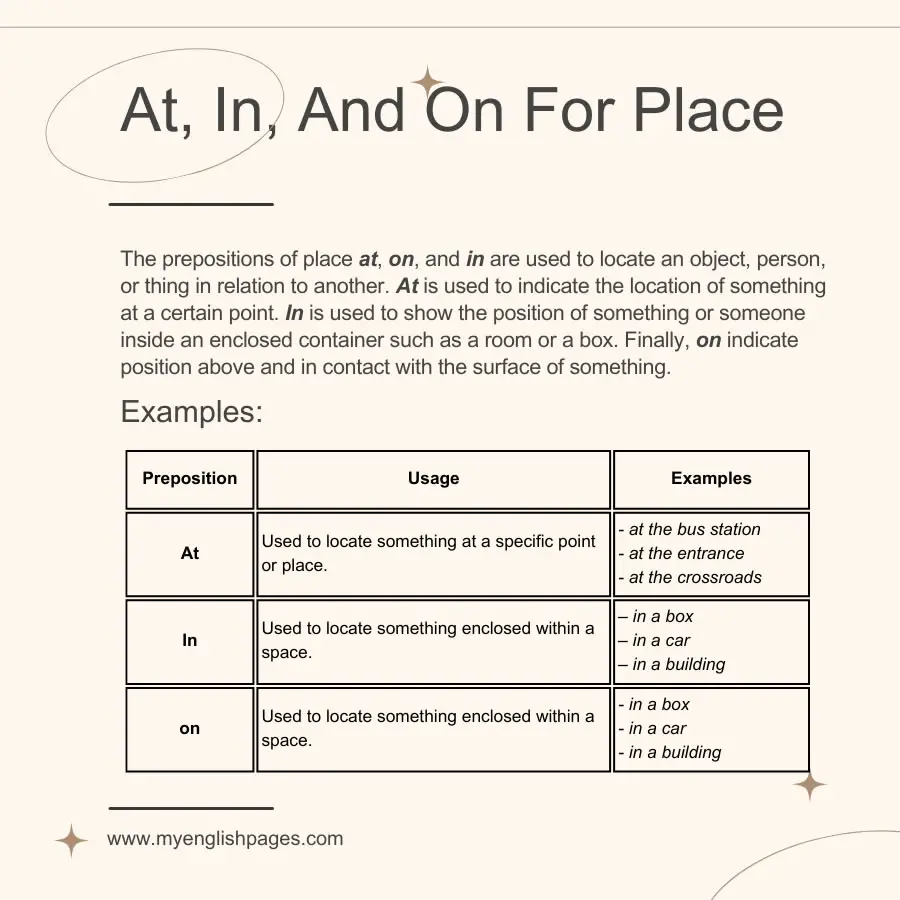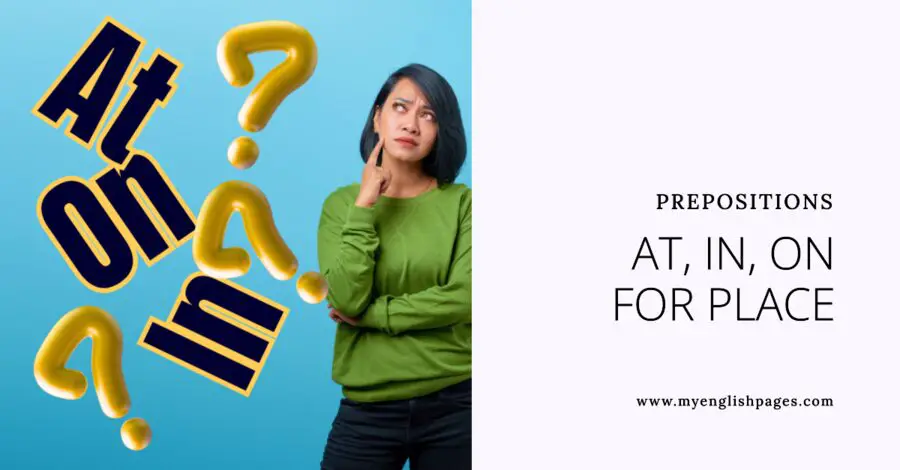Table of Contents
Introduction
Have you got a problem using the prepositions of place At, In, and On? Prepositions may cause a headache even for advanced learners. In this comprehensive guide, we’ll explain the proper usage of these prepositions of place. We will shed light on their distinct applications and provide valuable examples to enhance your understanding.
For an extended list of prepositions, check this guide on prepositions of place.
What Are Prepositions of Place?
Prepositions of place are concise words that indicate the location or position of an object, person, or thing in relation to another. They provide context about where something is situated in space. Common examples include “on,” “in,” and “at.”

At In On For Place
On, in, and at are prepositions of place. They refer to a place where something or someone is located. Using these small words can be sometimes confusing. This grammar lesson will help you understand how to use them in different situations.
Here are the rules for using at, in, and on:
How to Use The Preposition Of Place At?
At is used to locate something at a certain point:
Examples:
- at the bus station
- at the entrance
- at the crossroads
- at the junction
- at the top of the mountain
- at John”s house
Here are some examples:
- We were waiting at the bus stop when it started to rain.
- He was at the entrance of the theater when he heard the noise.
- She was at the coffee shop, enjoying a latte and reading a book.
- They waited for us at the airport, holding a sign with our names.
- The children played at the playground until the sun went down.
- I’ll meet you at the corner of Elm Street and Maple Avenue.
How to Use The Preposition Of Place In?
“In” is used to locate something enclosed in a space:
Examples:
- In a box
- In a car
- In a building
- In my pocket
- In my bag
- In New York
- In Spain
Here are some examples:
- They found a lot of money in his pocket
- I’ve lived in London for two years
- The treasure was hidden in a secret compartment in the old chest.
- She discovered a beautiful painting in the attic of her grandfather’s house.
- We spent our vacation in a cozy cottage by the lake.
- He found his car keys in the glove compartment of his car.
- The answers to the quiz are in the back of the textbook.
How to Use The Preposition Of Place On?
On is used to indicate position above and in contact with the surface of something:
Examples:
- On the wall
- On the door
- On the table
- On the ceiling
- On the carpet
- On the page
- On the cover
Here are examples showing the use of the preposition of place “on“:
- The picture on the wall is fantastic.
- You’ll find more information about the camp on this page.
- The cat is resting peacefully on the windowsill, enjoying the sunlight.
- She left a note on the kitchen counter explaining her whereabouts.
- The coffee mug on the table is mine; yours is on the shelf.
- We placed the book on the shelf, right next to the encyclopedia.
- The laptop on the desk is brand new; please handle it with care.
In or at?
Sometimes, it is possible to use either the preposition in or at in a sentence. But this may cause a change in the meaning of the sentence.
- I am at the bus stop.
- This means you are at a specific point in space near the bus stop.
- I am in the elevator.
- This, however, means that you are inside the elevator.
It is all a question of meaning. Changing the preposition causes a change in the meaning of your sentence.
Here’s a table summarizing the rules for using “at,” “in,” and “on” as prepositions of place:
| Preposition | Usage | Examples |
|---|---|---|
| At | Used to locate something at a specific point or place. | – at the bus station – at the entrance – at the crossroads – at the top of the mountain – at John’s house |
| In | Used to locate something enclosed within a space. | – in a box – in a car – in a building – in my pocket – in New York |
| On | Used to indicate position above and in contact with a surface. | – on the wall – on the door – on the table – on the ceiling – on the page |
Conclusion
In summary, the prepositions of place at, on, and in are used to locate an object, person, or thing in relation to another. At is used to indicate the location of something at a certain point. In is used to show the position of something or someone inside an enclosed container such as a room or a box. Finally, on indicate position above and in contact with the surface of something.


